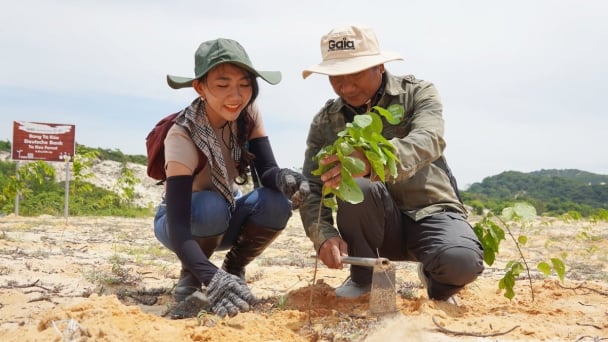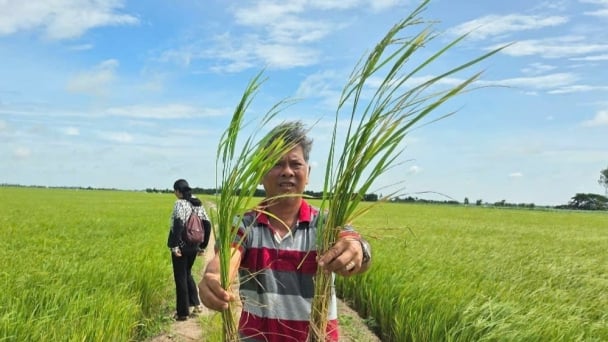September 1, 2025 | 12:10 GMT +7
September 1, 2025 | 12:10 GMT +7
Hotline: 0913.378.918
September 1, 2025 | 12:10 GMT +7
Hotline: 0913.378.918

Assoc. Prof. Dr. Phi Hong Hai, Deputy Director of the Vietnamese Academy of Forest Sciences. Photo: Bao Thang.
From a forest coverage rate of just over 27% in the late 1980s to today’s stable 42.02%, Vietnam’s forestry sector has come a long way, not only through manpower and land but also thanks to the solid foundation of science and technology. Technical advances in seedlings, silviculture, preservation, and processing have helped the industry escape its trade deficit position, reaching an export surplus of more than USD 14.4 billion in 2024 while achieving full autonomy in technology and raw materials.
According to Assoc. Prof. Dr. Phi Hong Hai, Deputy Director of the Vietnamese Academy of Forest Sciences, seedlings determine up to 60% of forest productivity and represent the breakthrough where science and technology have made the most dramatic strides. Since the 1990s, Vietnam has consistently adopted and improved international breeding technologies, especially for acacia and eucalyptus species. The acacia breeding program is considered outstanding in the region, applying many advanced technologies including molecular marker-assisted breeding, systemic selection, gene mutation, and tissue culture.
Propagation technologies have also fundamentally shifted, moving from uneven seed propagation to cutting and tissue culture, with transfers reaching households. As a result, planted forests now have straighter trunks, higher clear stems, better quality, and more uniform timber products.
Sustainability certifications (FSC, VFCS/PEFC), plantation coding systems, and traceability have also been strengthened, contributing to growth and export value. Certified forest areas now cover 663,216 hectares, of which 232,246 hectares are certified under the national standard (VFCS/PEFC), and 159 enterprises have achieved PEFC chain of custody certification.
For protection forests and degraded natural forests, science and technology focus on studying the characteristics of forest ecosystems, developing techniques for natural regeneration, enrichment planting, and combining under-forest agroforestry models such as ginseng, notoginseng, amomum, cardamom, codonopsis, stemona, and morinda.
Science and technology are also the key to processing – the stage that determines final value. From research on preservation and eco-friendly anti-fungal techniques to developing new materials from plantation timber, many innovative materials are serving construction and interior markets such as finger-jointed boards, laminated bamboo, blockboard, and molded wood panels. Numerous devices have been localized, such as soil sieving machines, seedling potting machines, nursery control systems, slope land diggers, vegetation-clearing equipment, and wood chippers – all aimed at reducing labor, improving efficiency, and ensuring product consistency.

Assoc. Prof. Dr. Phi Hong Hai at the forestry seed garden.
In seedlings, silviculture, or processing, science and technology are the hands that create products. But in policy and governance, they play the role of “architect,” shaping sustainable forest management, environmental protection, livelihood creation, and economic value. Research on forest ecosystem functions provides the scientific basis for implementing forest environmental service payments, where forest value is measured not only in timber but also in ecological functions such as water regulation, erosion reduction, and biodiversity conservation.
For protection forests and natural forests, science and technology underpin models of regeneration, enrichment planting, and under-canopy farming, while also opening new livelihoods. These models are built on the principle of multi-value use – exploitation, conservation, and ecotourism development. Forest-based tourism linked with OCOP (One Commune, One Product) products from native species is emerging as an economic driver for buffer zones.
Assoc. Prof. Dr. Phi Hong Hai affirms that forestry policies without data and scientific solutions are unlikely to work in practice. Research on payments for forest environmental services, carbon credits, and value chain linkages has been widely applied. The Forest Protection and Development Fund, once nonexistent, now generates VND 3,000–4,000 billion annually, helping forest growers and protectors maintain long-term commitment.
Thanks to these advances, Vietnamese forestry has shifted from state-run farms to enterprise and community-based management. People now earn a living from forests – a key measure of policy success. Clearly, science and technology not only support production and processing techniques but also lead development thinking, turning “sustainability” from a slogan into an operating principle.

Forest rangers use drones to monitor forest changes. Photo: Vietnam Administration of Forestry.
Assoc. Prof. Dr. Phi Hong Hai emphasizes that forestry is the story of long-cycle trees, requiring a deliberate, long-term strategy. Today’s achievements are only the beginning of a new vision, where science and technology move beyond supportive roles to become the leading force driving sustainable forest development, bringing higher benefits to forest growers.
Science and technology will also play a critical role in applying AI, remote sensing, and GIS to monitor resources, forecast and issue early warnings of pests and forest fires. In degraded natural forests, protection forests, and coastal forests, restoration solutions will rely on detailed site evaluations to enhance productivity and quality in line with multi-value, sustainable business models. The goal is to recreate forests close to their original state, maintain upstream watershed protection functions, minimize natural disasters, and respond effectively to climate change.
Forestry cannot develop in the short term; it requires long-term research programs spanning decades, approaching the entire closed chain from seedlings, cultivation, and silviculture to harvesting, processing, and market access. Among them, Resolution 57 of the Politburo is expected to shorten the path from laboratory to practice, turning research results into green forests, internationally certified wood products, and sustainable income for local people.
The future of forestry will not only be measured by forest area or export volume but also by sustainability, resilience, and added value for communities. When science and technology serve as the “brain” and “heart,” the sector will both meet market demands and preserve ecosystems.
When all forest management decisions are based on scientific data, forests will be greener and stand as a symbol of responsible production and deep integration. At that point, science and technology will not just be assistants but the pathfinders of forestry.
* $1 = VND 26.502 - Source: Vietcombank.
Translated by Huong Giang

(VAN) Vietnam is increasingly vulnerable to the impacts of climate risks and natural disasters. Without timely adaptation measures, climate change could cause the nation’s GDP to shrink significantly.
/2025/08/31/4433-3-134030_475.jpg)
(VAN) After 15 years of implementation, payments for forest environmental services have created a stable source of income, helping thousands of households and indigenous communities stick more with forests.
/2025/08/30/3629-3-183157_351.jpg)
(VAN) Prof. Dr. Phan Sy Ky, former Deputy Minister of Agriculture and Rural Development, affirmed, 'Never before has the irrigation sector had such a career and confidence as it does today.'
/2025/08/30/5239-5-024833_424.jpg)
(VAN) With the construction of the 'great canal' to channel freshwater and irrigation sluice and dike systems, the once acidic and alum-contaminated lands of Dong Thap Muoi and the Long Xuyen Quadrangle have revived.
/2025/08/29/5326-0-nongnghiep-105322.jpg)
(VAN) From a few hundred million USD in the late 1990s, Vietnam's wood exports have soared to USD 15 billion in 2025, affirming its status as a global powerhouse in wood processing and furniture manufacturing.

Instead of burning, microbial technology helps farmers turn millions of tons of straw into organic fertilizer, saving costs and protecting the environment.